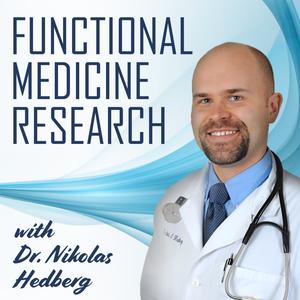
Functional Medicine Research with Dr. Nikolas Hedberg
Dr. Nikolas Hedberg, D.C. - Functional Medicine Researcher
Functional Medicine Research with Dr. Nikolas Hedberg
- 8 minutes 20 secondsPEA (palmitoylethanolamide) and Upper Respiratory Viruses
A new study entitled, “The Efficacy of Palmitoylethanolamide (Levagen+) on the Incidence and Symptoms of Upper Respiratory Tract Infection-A Double Blind, Randomised, Placebo-Controlled Trial” aimed to evaluate the effectiveness of a signaling lipid called Palmitoylethanolamide (PEA) in reducing the occurrence, duration, and severity of upper respiratory tract infections(URTIs).

The results showed that participants who took PEA experienced fewer URTI episodes and had reduced symptoms compared to those who took a placebo, suggesting that PEA may be a safe and effective treatment option for URTIs.
Palmitoylethanolamide (PEA) is a lipid compound that belongs to the N-acylethanolamine (NAE) family and has similar properties to endocannabinoids. In the context of cold and flu infections, PEA is suggested to regulate interleukins and inhibit mast cell production, thereby reducing inflammation.
PEA activates NF-κB pathways through peroxisome proliferator-activated receptors (PPAR), particularly PPAR-α, and concentration-dependent mechanisms to decrease NLRP3 and inflammasome activation, ultimately leading to a decrease in the expression of cytokines and alleviation of upper respiratory tract infection symptoms.
It is worth noting that the natural levels of PEA in the body and the use of PEA supplements have been found to be ineffective in producing significant clinical results due to poor absorption, resulting in low levels of PEA in the bloodstream. However, when PEA is combined with dispersion technology, such as Levagen+, the absorption of PEA is greatly improved, leading to higher concentrations in the bloodstream, which may enable a therapeutic effect.
This study was conducted over a period of 12 weeks. It was a double-blind, randomized, placebo-controlled trial, where participants were divided into two groups: an active group receiving 300 mg of Levagen+ PEA twice a day and a placebo group receiving maltodextrin. The purpose of the study was to investigate the efficacy of Levagen+ PEA compared to the placebo in terms of the incidence, severity, and duration of upper respiratory tract infections (URTI).
During the study, 87 participants out of the total enrolled experienced at least one URTI, resulting in a total of 103 URTI episodes. The group receiving Levagen+ PEA reported significantly fewer URTI episodes (39) compared to the placebo group (64), and a lower number of participants who fell sick at least once during the study (32 vs. 55) when compared to the placebo group.
Participants in the Levagen+ PEA group reported a significantly lower severity score for scratchy throat and cough. Overall, compliance with the study was high for both groups in terms of capsule consumption.
The findings of the study indicate that individuals in the Levagen+ PEA group had a significantly lower number of upper respiratory tract infection (URTI) episodes compared to the placebo group.
The study suggests that Levagen+ PEA could be a viable treatment for preventing upper respiratory tract infections (URTIs) and alleviating symptoms of cold and flu. The findings indicate that Levagen+ PEA is safe and effective in reducing the frequency of URTI episodes and relieving scratchy throats and coughing in individuals with URTI symptoms.
I use PEA Luteolin Select from Moss Nutrition, which contains 300 mg of Levagen+ PEA and 50 mg of the flavonoid luteolin per capsule. PEA and luteolin have been shown to work synergistically in COVID-19-related illnesses such as Long COVID.
I have patients take 1 capsule twice a day with meals of PEA Luteolin Select during COVID-19, cold, and flu season for prevention and then increase to 2 capsules three times a day when they feel like they’re coming down with something.
Hedberg Institute Members can download my latest upper respiratory tract infection protocols by logging in.
Click here to learn more about the Hedberg Institute Membership.
9 February 2024, 4:12 pm - 7 minutes 48 secondsMold Toxicity and Ginkgo Biloba
A new paper entitled “Isorhamnetin protects porcine oocytes from zearalenone-induced reproductive toxicity through the PI3K/Akt signaling pathway” investigated the effects of a natural flavonoid called isorhamnetin on the damage caused by a toxin called Zearalenone (ZEA) to pig oocytes (immature egg cells).

Zearalenone (ZEA) is a harmful mycotoxin found in moldy grain like corn, oats, and millet that can cause irreversible damage to the reproductive system of animals and humans. It can cause reproductive disorders by binding to estrogen receptors and has been shown to impair the development of sperm and oocytes in humans and animals.
ZEA can cause oxidative stress that leads to the production of reactive oxygen species (ROS), which can be harmful and contribute to cell death.
ZEA can also disrupt pregnancy, inhibit the meiosis of oocytes, and induce mitochondrial damage and stress in the maturation of oocytes. Since ZEA is heat-stable and cannot be completely eliminated from the food chain, it is important to explore potential compounds that can protect against ZEA-induced damage to oocytes.
In recent years, natural substances called flavonoids, which have antioxidant properties, have gained attention for their ability to support the development of oocytes. For example, quercetin has been found to increase the proportion of porcine oocytes developing into blastocysts, while kaempferol has shown potential in reducing the negative effects of aging on the development of porcine oocytes by improving mitochondrial function and reducing oxidative stress.
Isorhamnetin is a compound found in the herb ginkgo biloba and in foods like pears, onions, and peanuts. It has various pharmacological activities, such as being an antioxidant, anti-inflammatory, and antiviral.
Isorhamnetin acts as an antioxidant by decreasing the production of reactive oxygen species (ROS) and increasing the expression of SOD2 protein, which helps protect against oxidative stress.
This study found that isorhamnetin can protect the oocytes from ZEA-induced damage by improving their development, reducing oxidative stress, preventing mitochondrial dysfunction, and inhibiting apoptosis.
This research provides a potential solution for reproductive toxicity caused by ZEA and treating female infertility.
Mold Toxicity and Ginkgo Biloba Clinical Applications
Ginkgo biloba is rich in isorhamnetin as well as other powerful flavonoids like quercetin, kaempferol, and luteolin which makes it the perfect herb for patients with mold toxicity.
Ginkgo biloba has many benefits including anti-inflammatory, antioxidant, antiviral, anticoagulant, anti-obesity, hypolipidemic, hypotensive, anti-diabetic, anti-cancer, adaptogenic, and it protects the brain, eye, inner ear, heart, liver, cardiovascular system, reproductive system, lungs, and kidneys.
Patients with mold toxicity tend to have reactivated herpes viruses like EBV, CMV, and HHV-6 and ginkgo biloba is effective against these types of viruses as explained in this article.
I use VascuSelect from Moss Nutrition which contains 120 mg of standardized ginkgo biloba extract along with grape seed extract and mango extract to further support microcirculation. 120 mg of ginkgo biloba twice a day is the usual dose for this versatile herbal medicine.
If you’re a practitioner who sees patients with mold toxicity and/or infertility, then VascuSelect should be considered an important part of your protocol.
Click here to learn more about the Hedberg Institute Membership to take your functional medicine practice to the next level.
1 February 2024, 4:33 pm - 9 minutes 43 secondsLong COVID, Thromboinflammation and Immune Dysregulation
A new paper published in the journal Science entitled, “Persistent complement dysregulation with signs of thromboinflammation in active Long Covid” sheds light on the causes of Long COVID.
The authors begin by pointing out the current hypotheses about the causes of Long COVID, including persistent inflammation, autoimmunity, tissue damage, and viral reservoirs.
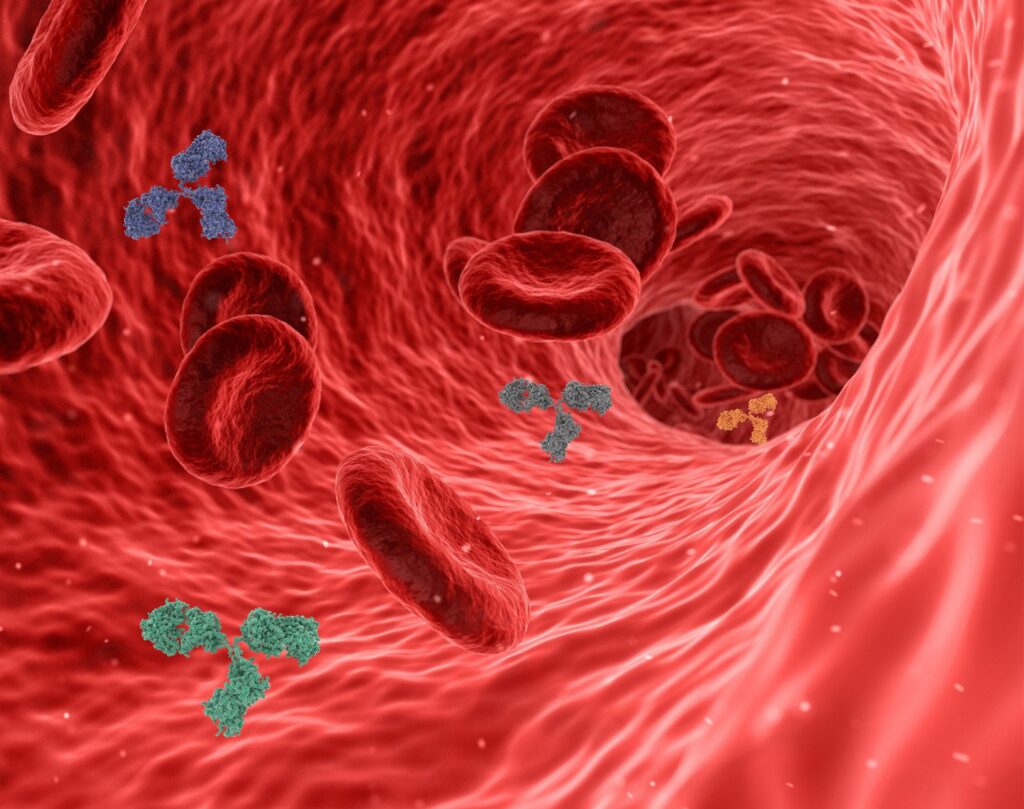
In this study, researchers followed 39 healthy individuals and 113 COVID-19 patients for up to a year to identify biomarkers associated with Long COVID. At the 6-month follow-up, 40 patients still experienced Long COVID symptoms. They collected blood samples and measured over 6500 proteins to identify potential biomarkers using computational tools and experimental evaluation.
In patients with Long COVID, there was an increased activation of the complement system, which is a part of the immune system that helps fight pathogens and damaged cells. This activation persists even after the acute phase of the disease. The complement system can cause damage to cell membranes, and in Long COVID patients, there is an imbalance in the formation of a complex called the terminal complement complex (TCC), also known as the membrane attack complex (MAC), which contributes to tissue damage.
Long COVID patients experienced increased markers of tissue injury in their blood, along with a thromboinflammatory signature. This means that there are signs of damage to tissues and an abnormal immune response involving the activation of endothelial cells and the breakdown of red blood cells. These findings suggest that Long COVID is associated with ongoing inflammation and potential blood clotting issues.
In patients with Long COVID, there are lower levels of antithrombin III, a protein that helps regulate blood clotting. This leads to increased cleavage by thrombin, which is a key factor in the formation of terminal complement complexes (TCCs).
Additionally, Long COVID patients show elevated markers of platelet activation and the presence of monocyte-platelet aggregates, particularly in cases where Long COVID symptoms persist for 12 months or more.
These patients also exhibit signs of antibody-mediated activation of the classical complement pathway, which is associated with increased levels of antibodies against cytomegalovirus (CMV) and Epstein-Barr virus (EBV).
In this study, the researchers also used a sensitive test to measure antinuclear antibodies (ANA) in patients with Long COVID. They found that patients with Long COVID had a higher prevalence of positive ANA results compared to those without Long COVID. Positive ANA tests can indicate autoimmunity.
Based on the data presented, it is suggested that Long COVID patients should undergo early cardiovascular assessment due to potential cardiovascular complications. Additionally, antiviral medications targeting SARS-CoV-2 or herpesviruses may help reduce inflammation and blood clotting in Long COVID patients. Therapies that target the terminal complement pathway could also be explored as potential treatment strategies for Long COVID and other post-infection syndromes.
Long COVID Clinical Applications
This paper confirms that inflammation of the blood vessels is common in Long COVID. Supporting microcirculation with herbs like ginkgo biloba, grape seed extract, and mango fruit powder can help reduce this inflammation and repair damaged blood vessels. These three herbs also are effective anti-viral agents against viruses like Epstein-Barr Virus (EBV) and Cytomegalovirus (CMV).
Ginkgo biloba has been shown to help improve the symptoms of Long COVID.
I use VascuSelect from Moss Nutrition which contains standardized forms of ginkgo biloba, grape seed extract, and mango fruit powder.
I also use palmitoylethanolamide (PEA) combined with luteolin to reduce inflammation and fight chronic viruses. Both of these are found in PEA Luteolin Select from Moss Nutrition. PEA and luteolin have been shown to work synergistically to help improve Long COVID symptoms.
Additional supportive compounds to reduce inflammation and balance the immune system in Long COVID patients include black cumin seed oil, curcumin, quercetin, resveratrol, fish oil, and vitamin D to name a few.
Hedberg Institute Members can download my latest Long COVID protocol by logging in.
Click here to learn more about the Hedberg Institute Membership.
25 January 2024, 2:21 pm - 9 minutes 23 secondsGinkgo Biloba’s Antiviral Properties
Ginkgo biloba, known for its distinctive fan-shaped leaves, has been used in traditional medicine for centuries, particularly in Asia. Ginkgo biloba is often touted as an herb for brain health, such as improving memory and cognition. This reputation does a great disservice to the most versatile herb in the world.
Ginkgo biloba can be used as a potent antiviral agent for a variety of viruses.
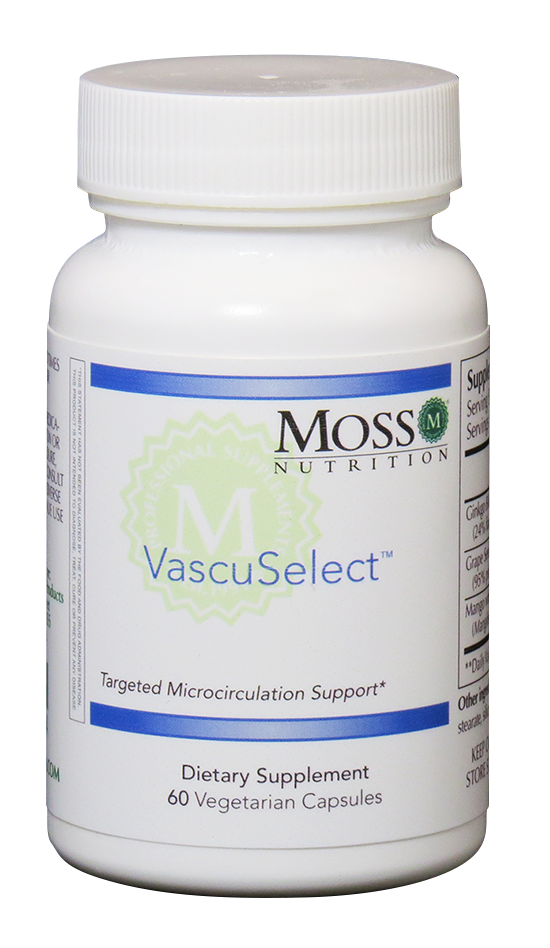
Ginkgo biloba has some key bioactive antiviral components:
Flavonoids and Terpenoids: Ginkgo leaves contain high levels of flavonoids and terpenoids, compounds known for their antioxidant properties. These substances contribute to the antiviral activity of the plant.
Ginkgolides and Bilobalides: These are unique terpene trilactones found in Ginkgo biloba, which have specific antiviral activities.
Ginkgo Biloba’s Mechanisms of Antiviral Action
The antiviral properties of Ginkgo biloba are multi-faceted, involving multiple mechanisms:
Inhibition of the fusions and synthesis of proteins in the viruses herpes simplex 1 and 2 (HSV-1 and HSV-2).
Inhibition of genome replication in cytomegalovirus (HCMV) and Zika virus (ZIKV).
Inhibition of viral fusion proteins in HIV, Ebola virus (EBOV), influenza A virus (IAV), and Epstein-Barr virus (EBV).
Inhibition of the targeting protein and DNA of coronoviruses (SARS-CoV-2), varicella zoster virus (VZV), and measles virus.
Inhibition of Viral Entry and Replication: Some studies suggest that Ginkgo biloba extracts can interfere with the ability of viruses to enter host cells or replicate. This is a key step in preventing the spread of viral infections.
Immune System Modulation: Ginkgo biloba might enhance the body’s immune response against viral infections. By modulating immune functions, it could help in controlling viral spread and severity.
Anti-inflammatory Effects: The anti-inflammatory properties of Ginkgo biloba can be beneficial in reducing the severity of symptoms associated with viral infections.
Research on Ginkgo Biloba’s Antiviral Properties
Anti-MERS-CoV and Anti-HCoV-229E Properties: A study focused on the antiviral activities of Ginkgo biloba leaf extracts against Middle East Respiratory Syndrome Coronavirus (MERS-CoV) and Human Coronavirus 229E (HCoV-229E).
Inhibition of Enveloped Viruses: Research published in Scientific Reports discussed how ginkgolic acid, a component of Ginkgo biloba, inhibits the fusion of enveloped viruses.
The study found that ginkgolic acid had a strong inhibitory effect on Human Cytomegalovirus (HCMV) and also tested its effects on Herpes Simplex Virus-1 (HSV-1) and Zika Virus (ZIKV).
Researchers also found broad spectrum inhibition by ginkgolic acid of all three classes of fusion proteins including HIV, Ebola virus (EBOV), influenza A virus (IAV) and Epstein Barr virus (EBV).
In addition, inhibition was found of a non-enveloped adenovirus.
The authors conclude that ginkolic acids may potentially be used to treat acute infections (e.g. Coronavirus, EBOV, ZIKV, IAV and measles), and also topically for the successful treatment of active lesions (e.g. HSV-1, HSV-2 and varicella-zoster virus (VZV)). It was observed that ginkgolic acid could inhibit the entry of these viruses into cells, thereby blocking viral replication.
Another study entitled, “Ginkgolic acids inhibit SARS-CoV-2 and its variants by blocking the spike protein/ACE2 interplay” found that ginkgolic acids from ginkgo biloba inhibited the SARS-CoV-2 virus from binding to the ACE2 receptor and thus could potentially be helpful in acute COVID-19 infections.
I use VascuSelect from Moss Nutrition which contains 120 mg of ginkgo biloba, 100 mg of grape seed extract, and 100 mg of mango fruit powder per capsule for acute and chronic viruses dosed 1 capsule once or twice a day with or without food.
Grape seed extract and mango fruit powder have also been shown to have antiviral properties. This trio of herbs not only has antiviral properties, but they also protect and repair the microcirculation which is damaged by viruses like SARS-CoV-2.
In summary, ginkgo biloba has exhibited diverse antiviral activities spanning multiple different types of viruses, indicating its potential clinical use as a supplemental antiviral agent.
Hedberg Institute Members can download full antiviral protocols by logging in.
Learn more about the Hedberg Institute Membership by clicking here.
References
- Hayder, M, Al-Kuraishy., Ali, I, Al-Gareeb., Ajeet, Kaushik., Małgorzata, Kujawska., Gaber, El-Saber, Batiha. (2022). Ginkgo biloba in the management of the COVID‐19 severity. Archiv Der Pharmazie, doi: 10.1002/ardp.202200188
- Maimoona, S, Bhutta., Daniel, G, Sausen., Elisa, S., Gallo., Harel, Dahari., Gustavo, F., Doncel., Ronen, Borenstein., Ronen, Borenstein. (2021). Ginkgolic Acid Inhibits Coronavirus Strain 229E Infection of Human Epithelial Lung Cells.. Pharmaceuticals, doi: 10.3390/PH14100980
- Manal, A., Ibrahim., Hanan, H., Ramadan., Rasha, N., Mohammed. (2021). Evidence that Ginkgo Biloba could use in the influenza and coronavirus COVID-19 infections.. Journal of basic and clinical physiology and pharmacology, doi: 10.1515/JBCPP-2020-0310
- Marta, Sochocka., Maciej, Sobczyński., Michał, Ochnik., Katarzyna, Zwolińska., Jerzy, Leszek. (2019). Hampering Herpesviruses HHV-1 and HHV-2 Infection by Extract of Ginkgo biloba (EGb) and Its Phytochemical Constituents.. Frontiers in Microbiology, doi: 10.3389/FMICB.2019.02367
- Ronen, Borenstein., Barbara, A., Hanson., Ruben, M., Markosyan., Elisa, S., Gallo., Srinivas, D., Narasipura., Maimoona, S, Bhutta., Oren, Shechter., Nell, S., Lurain., Fredric, S., Cohen., Lena, Al-Harthi., Daniel, A., Nicholson. (2020). Ginkgolic acid inhibits fusion of enveloped viruses.. Scientific Reports, doi: 10.1038/S41598-020-61700-0
- Dunja, Šamec., Erna, Karalija., Sabina, Dahija., Sherif, T., S., Hassan. (2022). Biflavonoids: Important Contributions to the Health Benefits of Ginkgo (Ginkgo biloba L.). Plants, doi: 10.3390/plants11101381
- Wei, Wang., Ke, Ma., Jiangtao, Liu., Feng, Li. (2019). Ginkgo biloba extract may alleviate viral myocarditis by suppression of S100A4 and MMP‐3. Journal of Medical Virology, doi: 10.1002/JMV.25558
- Jian-Ming, Lü., Shaoyu, Yan., Saha, Jamaluddin., Sarah, M., Weakley., Zhengdong, Liang., Edward, B., Siwak., Qizhi, Yao., Changyi, Chen. (2012). Ginkgolic acid inhibits HIV protease activity and HIV infection in vitro.. Medical Science Monitor, doi: 10.12659/MSM.883261
- Ezzat, H, Elshazly., Alyaa, Nasr., M., Elnosary., Gamal, Gouda., Hassan, Mohamed., Yuanda, Song. (2023). Identifying the Anti-MERS-CoV and Anti-HcoV-229E Potential Drugs from the Ginkgo biloba Leaves Extract and Its Eco-Friendly Synthesis of Silver Nanoparticles. Molecules, doi: 10.3390/molecules28031375
- Tian-Tong, Niu., Bo-yao, Yuan., G.-z., Liu. (2022). Ginkgolides and bilobalide for treatment of Alzheimer’s disease and COVID-19: potential mechanisms of action.. European Review for Medical and Pharmacological Sciences, doi: 10.26355/eurrev_202212_30702
- Dongsheng, Li., G., Yan., Wenwen, Zhou., Shuyi, Si., Xiaoping, Liu., Jing, Shang., Yan, Li., Yunyu, Chen. (2022). Ginkgolic acid and anacardic acid are reversible inhibitors of SARS-CoV-2 3-chymotrypsin-like protease. Cell & Bioscience, doi: 10.1186/s13578-022-00806-6
- Zinuo, Chen., Qinghua, Cui., Laura, Cooper., Pin, Zhang., Hyun, Lee., Zhaoyu, Chen., Yanyan, Wang., Xiaoyun, Liu., Lijun, Rong., Ruikun, Du. (2021). Ginkgolic acid and anacardic acid are specific covalent inhibitors of SARS-CoV-2 cysteine proteases. Cell & Bioscience, doi: 10.1186/S13578-021-00564-X
- Maimoona, S, Bhutta., Oren, Shechter., Elisa, S., Gallo., Stephen, D., Martin., Esther, Jones., Gustavo, F., Doncel., Ronen, Borenstein. (2021). Ginkgolic Acid Inhibits Herpes Simplex Virus Type 1 Skin Infection and Prevents Zosteriform Spread in Mice.. Viruses, doi: 10.3390/V13010086
- Xiang, Y., Zhai, G., Li, Y., Wang, M., Chen, X., Wang, R., Xie, H., Zhang, W., Ge, G., Zhang, Q., Xu, Y., Caflisch, A., Xu, J., Chen, H., & Chen, L. (2023). Ginkgolic acids inhibit SARS-CoV-2 and its variants by blocking the spike protein/ACE2 interplay. International journal of biological macromolecules, 226, 780–792. https://doi.org/10.1016/j.ijbiomac.2022.12.057
18 January 2024, 4:26 pm - 12 minutes 54 seconds3-Day Gut Reset Elemental Diet
For people with food sensitivities and chronic digestive disorders, the holiday season can be tough. Invitations to indulge in forbidden foods are everywhere—from checkout lines and television ads to office parties and family gatherings. For many, resisting temptation may be an insurmountable challenge.
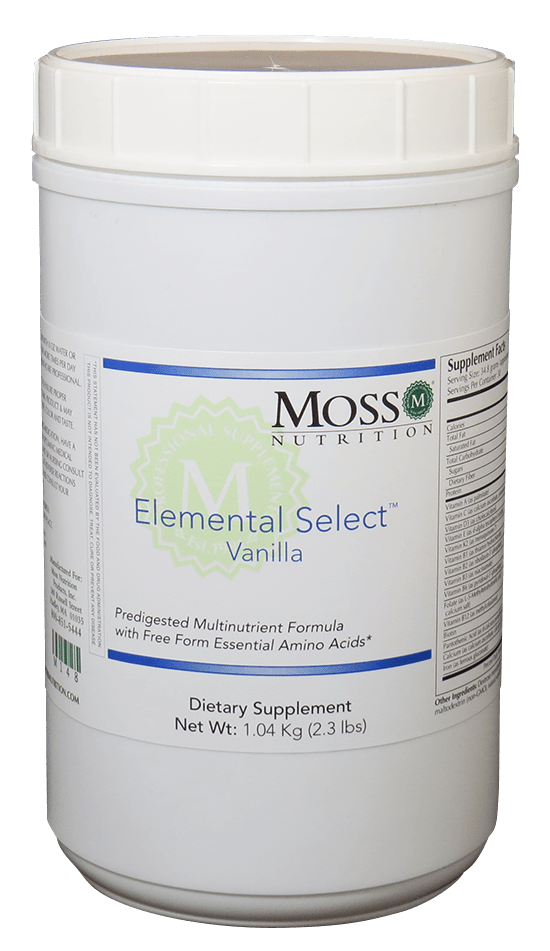
Sometimes, the visceral presence or memory of how a particular savory dish or sweet treat made one feel in the past is enough to cause one to forget (or simply not care) how that food will make one feel in the present. Which is to say: lousy. Bloated, flatulent, running to the toilet, or in pain. The aftermath of a holiday feast can leave anybody feeling a little sluggish the next day, but those with a medical reason to avoid certain foods might need extra support to recover.
A “3-Day Gut Reset” incorporating a full elemental diet is probably the quickest way to restore digestive function and comfort following such dietary indiscretions. This brief, modified, protein-sparing fast is easy to implement with a product such as Elemental Select™, Moss Nutrition’s tasty, vanilla flavored meal replacement powder.
Elemental Select™ contains all the essential vitamins, minerals, and macronutrients needed for proper physiologic function, in their “elemental” predigested forms. When mixed with water, this complete, easy-to-absorb nutritional shake can be consumed throughout the day without putting any strain on the digestive organs, enabling rapid intestinal healing and repair over the brief course of a three-day period.
Both full and partial elemental diets are recognized as important management strategies for people with digestive disorders. A full elemental diet, for example, was recently shown to prevent surgical recurrence of severe inflammatory bowel disease at a dose of 1200 calories per day. Decreasing intestinal inflammation, reversing leaky gut syndrome and intestinal permeability, rebalancing the microbiome, and improving digestive health are among the clinically researched benefits of elemental diet therapies.
Typically, elemental diets are employed over a period of two to six weeks. But shorter, intensive applications can help with rapid recovery from a relapse, such as may occur when patients with compromised digestion indulge in a holiday spree. A few days of full elemental diet protocol can make a significant difference in helping these folks get back on track and quickly feel their best.
One 30-serving container of Elemental Select™ is sufficient to complete an entire 3-Day Gut Reset. The patient simply consumes ten scoops of the product per day, and nothing else. (Each scoop contains 150 calories of bioavailable nutrition; therefore, ten scoops provide 1500 calories, enough energy for most people to function normally.)
The ten daily scoops may be divided in various ways, depending entirely on individual patient preferences. The most popular method is as follows: In a blender, combine two scoops of Elemental Select™ with 8 to 10 ounces of water. Consume five times per day, at regular intervals.
While two scoops, five times a day is ideal for most people doing a 3-Day Gut Reset, some may prefer to mix a single scoop in 8 ounces of water, and repeat ten times per day, generally on the hour.
Others may opt to divide their daily ten scoops into three or four equal servings, and replicate a “breakfast, lunch, and dinner” routine, with optional snack. (In this latter case, at least 16 ounces of water should be used to blend each “meal,” since several scoops of powder will be taken at once.) All these dosing options are absolutely fine.
Whatever schedule is chosen, it is critical to remember that Elemental Select™ is an extremely nutrient dense formula. Its nutrient density requires that Elemental Select™ must always be sipped slowly, never gulped. Using a straw may be helpful in ensuring this aim is met. If the product is consumed too quickly, stomach upset may occur. A good guideline is to allow 30 minutes for every 8 ounce serving. Using a timer may be helpful.
During the 3-Day Gut Reset, no other food or caloric substances should be consumed. Water and simple herbal teas, such as ginger, hibiscus, or peppermint tea, may be enjoyed liberally. If there is no citrus allergy, lemon juice is acceptable. Coffee should be avoided, but if caffeine withdrawal headaches are a concern, consider green tea, which is gentler on the system.
Along with all the known essential vitamins and minerals, Elemental Select™ features methylated B vitamins to optimize energy production and nervous system function.
Protein precursors are provided as free-form amino acids featuring L-carnitine, L-glutamine, and Reginator®, a proprietary blend of hypoallergenic essential aminos plus gut-friendly L-arginine. Reginator® has been shown to help increase and preserve muscle mass, even without exercise.
Two scoops of Elemental Select™ contain 3.6 grams of Reginator®, providing the muscle protein synthesis equivalent of 15-20 grams of whey or pea protein, to support lean body mass retention and optimization during the 3-Day Gut Reset.
Be sure to discuss the elemental diet and using Elemental Select with your doctor or healthcare provider.
References
Shinozaki M, Yokoyama T, et al. Elemental diet therapy plays a significant role in preventing surgical recurrence of Crohn’s disease in the era of biologics. Surg Today. 2021 Feb;51(2):250-257.
9 January 2024, 4:40 pm - 13 minutes 10 secondsLong COVID and Grapeseed Extract
Long COVID, also known as post-acute sequelae of SARS-CoV-2 infection (PASC) or long-haul COVID, refers to a condition where individuals experience persistent symptoms or develop new symptoms after recovering from the acute phase of COVID-19. Long COVID can affect individuals who had mild, moderate, or severe initial COVID-19 infections and can persist for weeks or months after the initial illness.
The specific symptoms and their duration can vary widely between individuals, but common symptoms of long COVID include fatigue, shortness of breath, cough, joint pain, chest pain, muscle weakness, brain fog, difficulty concentrating, memory problems, sleep issues, depression, anxiety, and other neurological or psychiatric symptoms. It can also affect multiple organs in the body, such as the heart, lungs, kidneys, and brain.

How does COVID-19 affect microcirculation?
Microcirculation refers to the circulation of blood in the smallest blood vessels, including arterioles, capillaries, and venules. While COVID-19 primarily affects the respiratory system, there is evidence suggesting that it can have systemic effects, including impacts on the cardiovascular system and microcirculation.
Here are some potential ways in which COVID-19 may affect microcirculation:
Endothelial Dysfunction:
COVID-19 has been associated with endothelial dysfunction, which is a condition where the cells lining blood vessels (endothelial cells) do not function properly. Endothelial dysfunction can lead to impaired regulation of blood flow and increased permeability of blood vessels.
In severe cases, viral infection and the resulting immune response may damage endothelial cells, contributing to a pro-inflammatory state and a potential disruption of microcirculation.
Blood Clotting and Thrombosis:
COVID-19 is known to be associated with an increased risk of blood clot formation (thrombosis). The formation of blood clots can potentially affect microcirculation by blocking small blood vessels.
The hypercoagulable state observed in some COVID-19 patients may contribute to microvascular thrombosis, leading to impaired blood flow in affected tissues.
Inflammatory Response:
The body’s inflammatory response to the virus can also impact microcirculation. Inflammation can lead to the release of inflammatory mediators, causing vasodilation (widening of blood vessels) and increased permeability, which may affect blood flow in the microcirculation.
Hypoxia and Tissue Damage:
Severe cases of COVID-19 may lead to respiratory distress and hypoxia (low oxygen levels). Hypoxia can have detrimental effects on tissues and organs, potentially impacting microcirculation.
Tissue damage and inflammation in the lungs may trigger a systemic response that affects microvascular function in other organs.
Impaired Oxygen Delivery:
In severe cases of COVID-19, where acute respiratory distress syndrome (ARDS) develops, oxygen exchange in the lungs becomes compromised. This can lead to inadequate oxygen delivery to tissues and affect microcirculation.
What is grapeseed extract?
Grapeseed extract is a dietary supplement derived from the seeds of grapes. It is rich in antioxidants, particularly compounds known as oligomeric proanthocyanidin complexes (OPCs). Additionally, grape seed extract contains flavonoids, another class of polyphenols with antioxidant properties.
These antioxidants help protect the body against damage from harmful free radicals, which can play a role in various chronic diseases. Grapeseed extract is commonly used for its potential health benefits, including improved cardiovascular health, reduced inflammation, enhanced immune function, and anti-aging effects.
How does grapeseed extract improve microcirculation in Long COVID?
The proanthocyanidins in grape seed extract help improve blood flow and circulation. By promoting the dilation of blood vessels, the extract supports the cardiovascular system’s ability to efficiently deliver oxygen and nutrients throughout the body.
Antioxidant Properties:
The proanthocyanidins and other antioxidants in grape seed extract have potent free radical-scavenging properties. By neutralizing free radicals, these antioxidants help reduce oxidative stress in the vascular system, including the microcirculation.
Oxidative stress can impair endothelial function and contribute to inflammation, both of which are factors that can negatively affect microcirculation. By mitigating oxidative stress, grape seed extract may support the health of blood vessels and improve microcirculatory function.
Anti-Inflammatory Effects:
Chronic inflammation can compromise microcirculation, leading to impaired blood flow and tissue damage. Some studies suggest that grape seed extract has anti-inflammatory effects, helping to modulate the inflammatory response.
By reducing inflammation, grape seed extract may contribute to maintaining the proper functioning of blood vessels in the microcirculation.
Endothelial Protection:
Endothelial cells line the inner surface of blood vessels, including those in the microcirculation. These cells play a crucial role in regulating blood flow and maintaining vascular health.
Grape seed extract has been studied for its potential to protect endothelial cells from damage. Preserving endothelial function is important for optimizing microcirculatory performance.
Vasodilation:
Some research suggests that grape seed extract has vasodilatory effects, meaning it can promote the relaxation and widening of blood vessels. Vasodilation improves blood flow and enhances the delivery of oxygen and nutrients to tissues, including those in the microcirculation.
The vasodilatory effects of grape seed extract may be attributed to its ability to enhance the production of nitric oxide, a molecule that helps regulate blood vessel tone.
Antithrombotic Properties:
Blood clot formation (thrombosis) can negatively impact microcirculation by blocking small blood vessels. Grape seed extract has been investigated for its potential antithrombotic properties, which may reduce the risk of abnormal blood clot formation.
By inhibiting platelet aggregation and reducing the formation of blood clots, grape seed extract may contribute to maintaining healthy microcirculation.
What does the research show about grapeseed extract and microcirculation?
The study “Pleiotropic benefit of monomeric and oligomeric flavanols on vascular health—a randomized controlled clinical pilot study” investigated the effects of monomeric and oligomeric flavanols (MOF) from grape seeds on vascular health. In a double-blind trial, 28 male smokers were given 200 mg/day of grapeseed extract for 8 weeks.
The study found significant reductions in serum cholesterol and LDL in subjects with elevated levels, and an increase in the glutathione to glutathione disulphide ratio in erythrocytes.
Grapeseed extract also exhibited anti-inflammatory effects in blood and reduced expression of inflammatory genes in leukocytes. Overall, the study demonstrated a considerable improvement in vascular health with grapeseed extract supplementation.
What other ways can grapeseed extract help Long COVID?
Long COVID is potentially linked to the progression of neurodegenerative diseases. Oxidative stress is implicated in the progression of neurodegenerative diseases such as Alzheimer’s and Parkinson’s. The antioxidants in grape seed extract help protect brain cells from oxidative damage, potentially slowing down the cognitive decline associated with aging.
Long COVID patients have chronic inflammation, which is another factor linked to cognitive decline and neurodegenerative diseases. Grape seed extract has demonstrated anti-inflammatory properties, which may contribute to reducing inflammation in the brain and supporting cognitive function.
What is the best way to take grapeseed extract?
My new formulation VascuSelect by Moss Nutrition is designed for microcirculation support including grapeseed extract, mango fruit powder, and ginkgo biloba for a synergistic effect.
One capsule twice a day provides 100 mg of grapeseed extract, 100 mg of mango fruit powder, and 120 mg of ginkgo biloba for optimal effectiveness. I use one capsule twice a day with my patients suffering from Long COVID.
You can read my articles on ginkgo biloba and Long COVID and mango fruit powder and Long COVID to learn more about how these compounds can help heal from Long COVID.
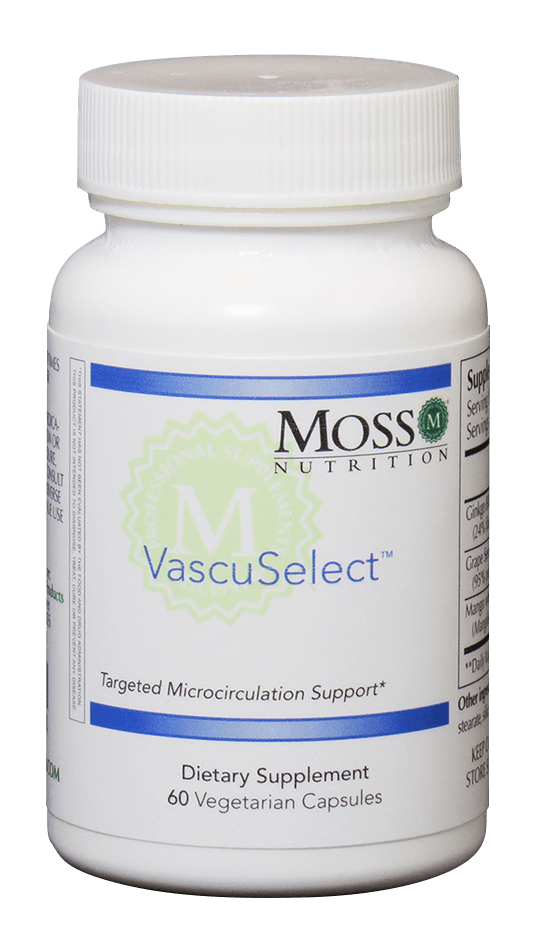
Are there any side effects with grapeseed extract?
In general, grape seed extract is well-tolerated by most individuals when taken within the recommended dosage range. However, some people may experience mild side effects, such as headache, dizziness, or digestive discomfort. If these side effects persist or worsen, it’s essential to seek guidance from a healthcare professional.
What about drug interactions?
Grape seed extract may interact with certain medications, including blood thinners, anticoagulants, and some antiplatelet drugs. Individuals taking these medications should exercise caution and inform their healthcare provider before starting grape seed extract supplementation.
Grape seed extract, with its array of bioactive compounds and antioxidant-rich profile, holds immense promise as a natural supplement for healing Long COVID. From cardiovascular and microcirculation support to cognitive protection, to its anti-inflammatory properties, the extract’s versatility makes it an excellent supplement for Long COVID symptoms.
Hedberg Institute Members can log in to access the latest Long COVID protocol and webinars on Long COVID.
To learn more about the Hedberg Institute Membership, click here.
14 December 2023, 6:58 pm - 11 minutes 6 secondsLong COVID and Mango Fruit Powder
SARS-CoV-2, the virus that causes COVID-19, can severely damage the body’s circulatory vessels, which inhibits oxygen, hormones, and nutrients from getting to vital body tissues.
Patients with Long COVID have been shown to have impaired microcirculation up to 18 months after infection, and possibly even longer if those vessels aren’t repaired.
Damaged microcirculation can lead to many of the symptoms of Long COVID including fatigue, difficulty recovering from exercise, brain fog, sluggish brain function, muscle weakness, depressed mood, loss of smell and taste, to name a few of the most common symptoms.
Mango fruit powder has been shown to improve microcirculation in a couple of excellent studies I will cover below.
Mango (Mangifera indica) has the following properties:
· Rich in polyphenols
· Activates Sirt-1 – antioxidant, improves endothelial function, anti-inflammatory, enhances metabolism
· Activates AMPK – improves muscle glucose uptake and fatty acid oxidation, hepatic fatty acid oxidation, lipid homeostasis, balances blood sugar, improves endothelial function
· Improves eNOS – improves endothelial function, increases energy, antioxidant
· Supports mitochondrial neogenesis
The first study entitled “Effects of Mangifera indica (Careless) on Microcirculation and Glucose Metabolism in Healthy Volunteers” was a double-blind, randomized study. The name “Careless” was changed to “Careflow” for good reason because it is more descriptive of the benefits of mango fruit powder.
204 subjects were divided into three groups. One group took 100 mg a day of mango fruit powder. The second group took 300 mg of mango fruit powder. And the third group was the placebo group. Mango fruit powder was taken every day for 4 weeks.
Microcirculation and endothelial function were assessed.
Microcirculatory reactive hyperemia flow increased, especially in the 100 mg group.
300 mg of the mango fruit preparation reduced postprandial glucose levels compared to placebo, accompanied by significantly lower HbA1c values compared to baseline.
300 mg intake significantly improved postprandial endothelial function in individuals with decreased endothelial function after high-dose glucose intake.
Both doses were well tolerated without side effects.
The second study entitled “In Vitro Activation of eNOS by Mangifera indica (Careless™) and Determination of an Effective Dosage in a Randomized, Double-Blind, Human Pilot Study on Microcirculation” showed similar results on microcirculation.
In this study, a dose of 100 mg or 300 mg of mango fruit powder was given to see the effects on microcirculation in a randomized, double-blind, crossover pilot study in ten healthy women.
Both doses improved cutaneous blood flow, indicating improved microcirculation.
Both doses were well tolerated without side effects.
Both of the above studies clearly show the benefits of mango fruit powder on microcirculation which can help patients with Long COVID.
Why not just eat mangos?
Careflow, the mango fruit powder used in these studies, is standardized to 0.03% mangiferin which is vital for maximum effectiveness.
Additionally, the mango subspecies used in Careflow is called “Kili-mooku” as opposed to the “Alfonso” mangos found in supermarkets. Mangos are cultivated in the South of India in the Tamil Nadu region as opposed to Brazil and Peru where commercial mangos come from.
Kili-mooku mangos are harvested just at the right time when the beneficial plant ingredients are at their highest levels and manufactured in Germany to the highest standards.
I designed VascuSelect by Moss Nutrition to contain 100 mg of Careflow standardized mango whole fruit powder along with grape seed extract and ginkgo biloba to repair and restore microcirculation.
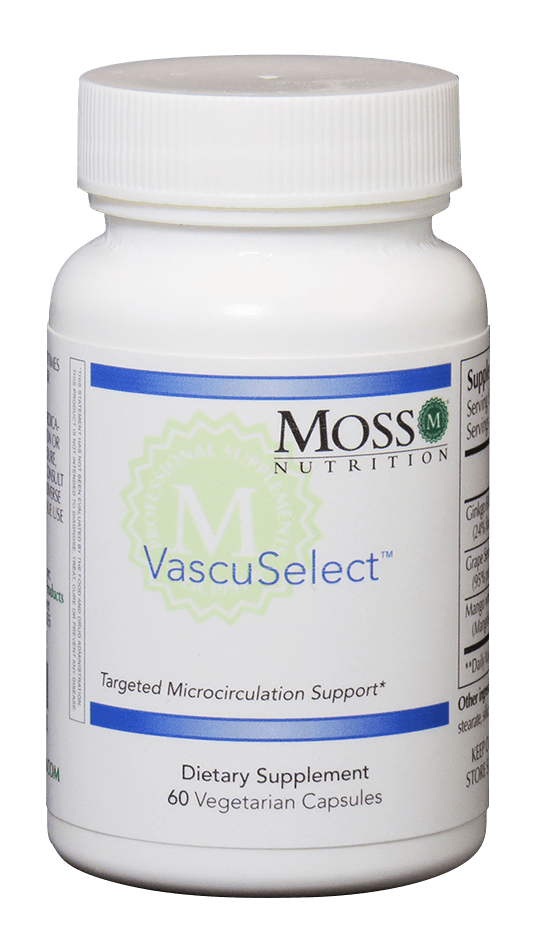
This makes VascuSelect a perfect formula for those suffering with Long COVID. I use one capsule twice a day with my patients suffering from Long COVID.
If you’d like to read about the beneficial effects of ginkgo biloba on Long COVID, read my article here. And to read my article on grapeseed extract and Long COVID, click here.
Hedberg Institute Members can log into your account and download my latest Long COVID protocol.
Click here to learn more about the Hedberg Institute Membership.
29 November 2023, 3:07 pm - 9 minutes 4 secondsLong COVID and Ginkgo biloba
5 case reports were reported in an excellent paper on ginkgo biloba and Long COVID symptoms.
Patients with Long COVID were given 80 mg of ginkgo biloba extract (EGb 761) twice a day.
Patient 1 took ginkgo biloba for 11 weeks, and he had a substantial improvement in cognitive concerns, decreased perception of fatigue and an improvement in olfaction. He completely regained his sense of smell.
Patient 2 took ginkgo biloba for 13 weeks and reported improvement in concentration and fatigue.
Patient 3 took ginkgo biloba for 4 months and reported significant improvement in cognitive deficits.
Patient 4 took ginkgo biloba for 7 weeks and reported improved concentration and fatigue.
Patient 5 took ginkgo biloba for 6 weeks and reported improvement in depression, fatigue, irritability, and hyposmia.
Two of these patients reported complete remission of their cognitive symptoms.
None of the patients had any adverse effects.
SARS-CoV-2, the virus that causes COVID-19, has been shown to damage the microcirculation blood vessels resulting in decreased blood flow to vital tissues such as the heart, kidney, muscle tissue, ear, eyes, liver, brain and nervous system.
Ginkgo biloba has been shown to protect and repair large and small blood vessels, as well as a host of other body tissues. Ginkgo biloba has antioxidant properties, improves circulation, repairs and protects the brain, nervous system, eye, ear, kidney, intestine, heart, and cardiovascular system.
This makes ginkgo biloba a perfect herbal medicine for Long COVID, and the results of these case reports are not surprising.
How best to take ginkgo biloba?
Ginkgo biloba is usually dosed 120-240 mg a day in one or two doses with or without food. It can disrupt sleep, so some people may need to take it in the morning and no later than the early afternoon.
The dose used in this study was 80 mg twice a day totaling 160 mg a day. But the author’s point out that a higher dose may have yielded even better results.
I normally use 120 mg twice a day with my patients. Ginkgo biloba side effects such as headache only occur in 2% of people who take it.
It can take up to six weeks to notice the full effects of ginkgo biloba so give it some time to work.
My formula VascuSelect from Moss Nutrition contains 120 mg of ginkgo biloba per capsule with added grape seed extract and mango fruit powder. Grape seed extract and mango also support and repair microcirculation for a synergistic effect with the ginkgo biloba.

Ginkgo biloba should be standardized to 24% flavonol glycosides and 6% terpenes for maximum effectiveness.
Please be sure to consult with your licensed healthcare professional before supplementing with ginkgo biloba due to potential risks of bleeding disorders. Certain medications can increase the risk of bleeding when combined with ginkgo biloba.
Long COVID is having devastating consequences on society and new natural treatments are constantly emerging to help.
Ginkgo biloba is now part of my evidence-based core Long COVID protocol.
To learn more about grapeseed extract and Long COVID, click here to read my article. And to learn how mango fruit powder can help Long COVID, click here.
Hedberg Institute Members can log in and download my latest Long COVID protocol.
To learn more about the Hedberg Institute Membership, click here.
9 November 2023, 3:19 pm - 8 minutes 14 secondsUpper Respiratory Infections and PEA (palmitoylethanolamide)
The endogenous compound PEA (palmitoylethanolamide) is a natural anti-inflammatory agent which works in affiliation with the endocannabinoid system to help modulate pain. PEA was first discovered in the 1950s after being isolated from the lipid fraction of egg yolk. In recent years, PEA research has largely focused on neuropathic pain states and mast cell related disorders. However, earlier research often was directed toward the ability of PEA to support upper respiratory health, a line of inquiry stemming from prior observations regarding the efficacy of egg yolk in preventing rheumatic fever.

PEA for Cold and Flu
During the 1970s, six large placebo-controlled trials were conducted to investigate PEA as a cold and flu therapy. For this research, commercial grade PEA (trade name Impulsin) was used. These early studies, which engaged close to 4,000 subjects in total, yielded remarkable results. Trials conducted during the flu season demonstrated significant efficacy in both prophylaxis and treatment, with no adverse effects reported.
In a study where adult subjects took 600 mg of PEA three times per day or an identical placebo, incidence of disease over a twelve-week period was reduced by up to 40% in the PEA group.
In another trial, subjects with cold or flu who took PEA missed significantly fewer days of work, and experienced significantly less fever, headache, and sore throat than subjects taking placebo. Follow-up studies designed to replicate these findings further showed a significant reduction in acute respiratory infections after administration of PEA. The ability of PEA to downmodulate proinflammatory cytokine activity was proposed as a primary mechanism of action.
In the decades since this early research was performed, enhanced absorption PEA enabling higher efficacy at lower doses has been developed. One such PEA formulation, Levagen+, exhibits up to 75% increased absorption compared to commercial PEA, and has been clinically researched in humans for a variety of uses, including upper respiratory health.
PEA and COVID-19
A recent, double-blind, placebo-controlled study gave 600 mg of Levagen+ PEA or placebo twice daily to non-vaccinated outpatients with verified mild to moderate COVID-19 infection. Serum inflammatory biomarkers were evaluated at baseline, and after four weeks of treatment. At the end of the study period, only subjects in the Levagen+ group exhibited significant reductions in inflammatory biomarkers, most notably in levels of P-selectin, a thromboinflammatory marker known to be elevated in cases of severe COVID and other conditions marked by increased inflammation and thrombosis, for example, cardiometabolic disease.
Levagen+ is the form of PEA used in Moss Nutrition PEA Luteolin Select™. The product also contains luteolin, an antioxidant bioflavonoid shown to work synergistically with, and enhance, the benefits of PEA.
Hedberg Institute members can log in to access the COVID-19, Long COVID, cold, and flu protocols.
Practitioners who are interested in learning more about the Hedberg Institute Membership click here for more details.
References:
19 October 2023, 2:17 pm - 12 minutes 25 secondsLong COVID, PEA and Luteolin
Palmitoylethanolamide (PEA) is a naturally occurring endocannabinoid-like lipid mediator naturally found in many plants. PEA is analgesic, immunomodulatory, neuroprotective, antipyretic, antiepileptic, anti-inflammatory, anticonvulsant, antibacterial and antiviral. PEA also increases endocannabinoids and it down regulates mast cell activation.

PEA can improve immune system function without increasing inflammation. PEA also regulates fatty acid metabolism, reduces oxidation of fats, and inhibits excessive nitric oxide.
PEA may contribute to enhanced muscle recovery and improved cognition, mood and sleep. PEA may be indicated for anti-aging, immunoenhancement, brain health, allergies, and joint health.
These properties make PEA a perfect compound for managing the difficult symptoms of Long COVID.
Studies on PEA and Long COVID
A recent study entitled, “The Use of Palmitoylethanolamide in the Treatment of Long COVID: A Real-Life Retrospective Cohort Study” looked at the potential benefits of PEA for Long COVID symptoms. Some of the most common Long COVID symptoms include fatigue, brain fog, headache, exercise intolerance, trouble breathing, memory lapse, anosmia, dysgeusia, depression, anxiety, psychosis, nervous asthenia, PTSD, insomnia, delirium and anhedonia.
How was the study done?
33 (10 male and 23 female) patients were given 600 mg PEA twice a day for 3 months. All patients were administered the post-COVID-19 Functional Status (PCFS) scale, to assess meaningful function, before (T0) and at the end of the treatment (T1). None of the patients had any side effects from the PEA.
Study results
All the patients experienced improvement in their Long COVID symptoms as measured by the Post-COVID-19 Functional Status scale.
PEA, Luteolin, and Long COVID Studies
The combination of PEA and Luteolin has been studied extensively, with multiple published papers showing the synergistic benefits of these two compounds. PEA and luteolin have been shown to reduce neuroinflammation by modulating microglia and reducing reactive oxygen species (ROS).
Luteolin is a flavonoid, specifically a flavone, found naturally in fruits, vegetables, and herbs such as celery, parsley, lettuce, spinach, peppers, broccoli, cabbage, carrots, onions (leaves), and apples (skins). Luteolin is similar in structure to quercetin, but luteolin is more potent and is sometimes referred to as a “supercharged” quercetin.
Luteolin has the following properties:
- Anti-inflammatory
- Anti-neurodegenerative (neuroprotective)
- Mast cell stabilizer
- Antioxidant
- Anticancer
- Antiallergy
- Antihypertensive
- Antiviral
- Antidiabetic
Another study entitled, “What Is the Role of Palmitoylethanolamide Co-Ultramicronized with Luteolin on the Symptomatology Reported by Patients Suffering from Long COVID? A Retrospective Analysis Performed by a Group of General Practitioners in a Real-Life Setting” looked at the medical charts of 49 patients with Long COVID who were treated by one of nine doctors in Rome, Italy.
The patients were treated with 700 mg of PEA and 70 mg of luteolin twice a day for 90 days.
No side effects were reported during treatment, nor any drug interactions with their medications.
The authors conclude, “Supplementation with PEALUT (PEA and Luteolin) helped to improve all patient-reported symptoms, especially pain, anxiety and depression, fatigue, brain fog, anosmia and dysgeusia, leading to an overall improvement in patients’ health status.”
PEA and luteolin have been found to be effective for post-COVID loss of smell (anosmia) and memory loss.
The first study entitled, “Ultramicronized Palmitoylethanolamide and Luteolin Supplement Combined with Olfactory Training to Treat Post-COVID-19 Olfactory Impairment: A Multi-Center Double-Blinded Randomized Placebo- Controlled Clinical Trial” was done for 90 days on subjects who took 700 mg of PEA and 70 mg of luteolin once a day combined with olfactory training.
The results of this study found that those supplementing with PEA and luteolin had significant improvements and even resolution of their loss of smell compared to the placebo group who only did olfactory training.
The second study entitled, “Parosmia COVID-19 Related Treated by a Combination of Olfactory Training and Ultramicronized PEA-LUT: A Prospective Randomized Controlled Trial” was virtually identical to the first study. Subjects took 700 mg of PEA and 70 mg of luteolin along with olfactory training for 90 days, and they achieved significant results compared to the control group.
The third study entitled, “Treatment of COVID-19 olfactory dysfunction with olfactory training, palmitoylethanolamide with luteolin, or combined therapy: a blinded controlled multicenter randomized trial” set out to see if doubling the dose of PEA and luteolin to 700 mg of PEA and 70 mg of luteolin taken twice a day was superior to just once a day dosing.
The results were surprising because there was no difference between the single dose or doubling the dose. This is good news for patients because this results in a significant cost-savings.
The fourth study entitled, “Effect of Ultra-Micronized Palmitoylethanolamide and Luteolin on Olfaction and Memory in Patients with Long COVID: Results of a Longitudinal Study” used the same dose as the above studies of 700 mg of PEA and 70 mg of luteolin combined with olfactory training and found significant improvements in olfaction and improved memory/brain fog.
The one common thread among all the above studies was the importance of olfactory training along with the PEA and luteolin supplement.
How best to take PEA and Luteolin?
PEA is not well absorbed, so it must be delivered in a specific form called Levagen+. Levagen+ PEA uses LipiSperse technology to enhance the absorption of PEA.
Most of the studies on Levagen+ PEA used 300 mg twice a day with excellent results. For more complex cases, 600 mg twice a day of Levagen+ PEA may provide better results.
The therapeutic dose of luteolin is 100-200 mg a day, since it is a potent flavonoid.
Moss Nutrition’s product PEA Luteolin Select contains 300 mg of Levagen+ PEA and 50 mg of luteolin per capsule. I use one capsule twice a day with meals for most patients, and two capsules twice a day for more complex cases.
Long COVID patients are experiencing more and more viable supplement options, and the combination of PEA and luteolin is now part of my core Long COVID protocol.
Hedberg Institute members can download my Long COVID protocol in the Practice Tools section of your membership area. Hedberg Institute members also get access to all my course material on how to treat Long COVID.
19 September 2023, 2:37 pm - 11 minutes 6 secondsLong COVID, CoQ10 and Alpha Lipoic AcidA new study entitled, “Coenzyme Q10 + alpha lipoic acid for chronic COVID syndrome” has been published in the journal Clinical and Experimental Medicine which found that supplementation with Coenzyme Q10 (CoQ10) and alpha lipoic acid (ALA) may be helpful in Long COVID. COVID-19 can deplete CoQ10 levels and damage the mitochondria which are important for energy production and immune system function. CoQ10 and alpha lipoic acid can both be helpful in protecting and supporting mitochondrial function by reducing oxidative stress. CoQ10 deficiency can lead to decreased energy production resulting in fatigue and increased free radical production. Fatigue is by far the most common symptom reported in Long COVID so CoQ10 is at the top of the list of supplements to try with this condition. Alpha lipoic acid is a powerful antioxidant, and it is involved in mitochondrial energy production. ALA also has immunomodulatory properties and may actually be an anti-viral as well. The properties of both nutrients in theory make them a promising combination in the treatment of Long COVID. How was the study done? 174 patients (51% male and 49% female) aged 18-81 (mean of 51) who had COVID-19 previously and met the 2015 National Academy of Medicine diagnostic criteria of myalgic encephalomyelitis/chronic fatigue syndrome (ME/CFS). 52% had comorbidities including chronic lung disease (16%, 28/174), diabetes mellitus (13%,23/174), psychiatric diseases (7.5%, 13/174), and rheumatic diseases (9.8%, 17/174). 17.8% (31) of patients had been previously hospitalized for severe respiratory SARS-CoV-2 pneumonia. 82.2% had mild/moderate symptoms during the acute phase. The mean duration of Long COVID symptoms was 5.9 months. The most common symptoms were fatigue (80%), impaired concentration (68%), sleep disorders (85%) disturbed smell and/or taste (60%), memory loss (45%), dyspnea (21%) and arthromyalgias (64%). Patients were divided into two groups. The first one (116 patients) received coenzyme Q10 (ubiquinone form) and alpha lipoic acid taken every day for two months at a dose of 100 mg of CoQ10 and 100 mg of alpha lipoic acid twice a day. The control group of 58 patients did not take either supplement. The characteristics of the patients in the two groups were similar at baseline. Patients in both groups also received a variety of medications including paracetamol, codeine, NSAIDS, antidepressants (duloxetine), anticonvulsants and analgesics (pregabalin and gabapentin). They also undertook psychological and psychiatric counseling, physio-kinesiotherapy, yoga, and Pilates. What were the results? “The primary end-point was to evaluate the effectiveness of the association of coenzyme Q10 and alpha lipoic acid in reducing fatigue, expressed as a reduction in Fatigue Severity Scale (FSS), at the second month (T1), of at least 50% (complete response) from the baseline (T0) or at least 20% (partial response) from the baseline (T0). A reduction in FSS < 20% from baseline at T1 was considered as a non-response. A complete FSS response was reached most frequently in the treatment group compared to the control group. An FSS complete response was reached in 62 (53.5%) patients in the treatment group and in two (3.5%) patients in the control group. A reduction in FSS score < 20% from baseline at T1 (non-response) was observed in 11 patients in the treatment group (9.5%) and in 15 patients in the control group (25.9%) (p < 0.0001).” Author's Conclusion “Despite the short follow-up period, we demonstrated a clinical benefit, suggesting the rapid effect of this therapy. On the other hand, because of the short follow-up duration, we do not know if this clinical benefit persists over time. Our results, all based on subjective indices, were definitely in favor of the treatment group.” Dr. Hedberg’s Comments on Long COVID, CoQ10, and Alpha Lipoic Acid This study shows promising results in the use of coenzyme Q10 and...13 July 2023, 3:58 pm
- More Episodes? Get the App
Your feedback is valuable to us. Should you encounter any bugs, glitches, lack of functionality or other problems, please email us on [email protected] or join Moon.FM Telegram Group where you can talk directly to the dev team who are happy to answer any queries.
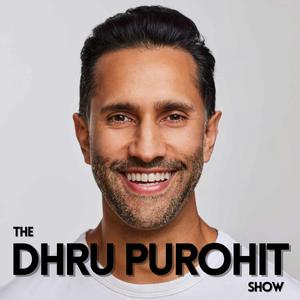 Dhru Purohit Show
Dhru Purohit Show
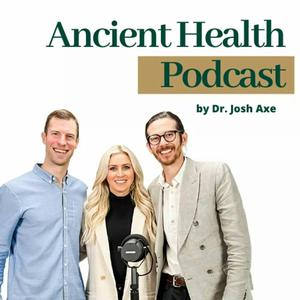 Ancient Health Podcast
Ancient Health Podcast
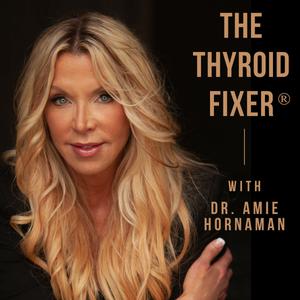 The Thyroid Fixer
The Thyroid Fixer
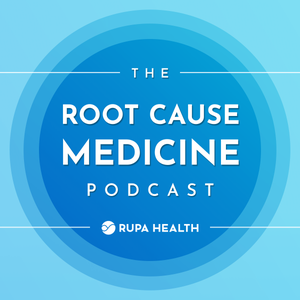 The Root Cause Medicine Podcast
The Root Cause Medicine Podcast
 Revolution Health Radio
Revolution Health Radio
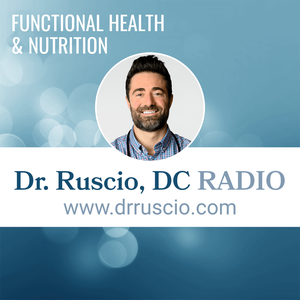 Dr. Ruscio Radio, DC: Health, Nutrition and Functional Healthcare
Dr. Ruscio Radio, DC: Health, Nutrition and Functional Healthcare